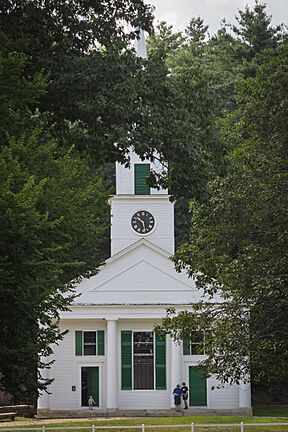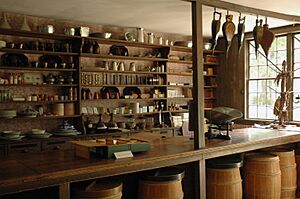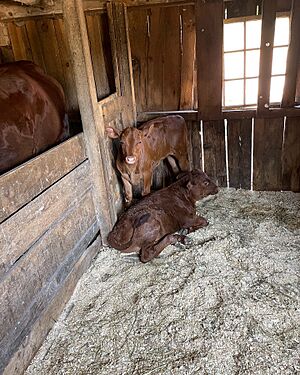Old Sturbridge Village facts for kids
Quick facts for kids Old Sturbridge Village |
|
|---|---|
|
Center Meetinghouse
Freeman Farm
Salem Towne House
Gristmill
Sheep at Fenno Barn
Thompson Bank
Horses at trough
|
Old Sturbridge Village is a special museum in Sturbridge, Massachusetts. It's like stepping back in time to rural New England between the 1790s and 1830s. This huge museum covers over 200 acres (81 hectares) and is the biggest living museum in New England.
The Village has 59 old buildings, three water-powered mills, and a working farm. People dressed in 19th-century clothes show how people lived. They demonstrate old arts, crafts, and farm work. Many tourists visit, and it's a popular place for school field trips.
Contents
History of Old Sturbridge Village
In the early 1800s, the land where Old Sturbridge Village now stands was a farm. It belonged to David Wight and had a sawmill, a gristmill, and a pond. The pond was dug in 1795 and still helps power the mills today.
How the Millpond Was Built
In 1795, David Wight's son went to Boston for business. While there, he bought tickets for the Harvard Lottery. This lottery helped raise money for Harvard College. He won $5,000, which was a lot of money back then!
He gave the money to his father to pay off the farm's mortgage. They also cut down trees in a swamp, which is now the millpond. After clearing the trees, they dug the pond using oxen and a scoop. This big project took two and a half years to finish.
The Wells Family and Their Collections
George Washington Wells started a small shop in Southbridge, Massachusetts, in the 1840s. He made eyeglasses, and his business grew into the American Optical Company. His sons, Channing, Albert (called "AB"), and Cheney, joined the company.
In 1926, AB started collecting old items. This inspired Cheney to collect old American clocks and Channing to collect beautiful furniture. By the early 1930s, AB had filled more than 45 rooms in his home with antiques!
Creating the Village Museum
In 1935, the Wells family and others created the Wells Historical Museum. They gave their collections to the museum to be cared for and shown to the public. In 1936, the museum's leaders met to decide how to display the items.
AB wanted to build a few buildings around a common area. But his son, George B., had a different idea. He suggested creating a "live village" with working shops and water power. Within a week, the museum bought David Wight's old farm. They soon hired Malcolm Watkins as the first curator. They first called the museum Quinnebaug Village.
Architect Arthur Shurcliff helped design the village's landscape. By 1941, some buildings were already in place. These included the Fitch House, the Miner Grant Store, and the Richardson House (now called the Parsonage). The Gristmill was also working.
Opening and Growth of the Village
After a break for World War II, George B.'s wife, Ruth, became the acting director. They changed the museum's name to Old Sturbridge Village. It officially opened on June 8, 1946. More and more people visited, mostly by hearing about it from others.
In 1950, an article in The Saturday Evening Post called the village "The Town That Wants to be Out of Date." By 1955, the Village had added many more buildings. These included the Meetinghouse, the Salem Towne House, the Fenno House, the Friends Meetinghouse, the Pliny Freeman House, the Printing Office, and the District School.
Surviving Hurricane Diane
On August 18, 1955, a very strong storm called Hurricane Diane hit the area. It brought strong winds and heavy rain. Dams in nearby towns broke, and the Village flooded. Fifteen staff members were stuck inside.
The Freeman Farmhouse was flooded, and the covered bridge was washed away. Helicopters brought supplies to the staff for three days until the water went down. The damage was estimated at $250,000 in 1955. But the Village employees worked hard and managed to reopen the museum in just nine days!
Structures and Exhibits
Old Sturbridge Village has over 40 buildings. Many of these are original buildings that were bought and moved from other places in New England. Some are also careful copies of old buildings. The entire village is split into three main areas.
Center Village
The Center Village is the heart of the town, with the town green in the middle. Here you can find:
- Friends Meetinghouse – A meeting place for the Religious Society of Friends, also known as Quakers.
- Center Meetinghouse – Churches often served as places for town meetings, elections, and talks.
- Tin Shop – Here, tin from England was used to make many items for homes.
- Salem Towne House – The home of a successful farmer.
- Law Office – A small, separate office where a lawyer worked.
- Parsonage – The home of a minister and his family.
- Asa Knight Store – A country store that was moved from Vermont.
- Thompson Bank – A bank that was originally in Thompson, Connecticut.
- Fenno House – A historic house showing how people made textiles at home.
- Fitch House – A home exhibit that focuses on children and family life.
- Small House – A small home built from scratch using old techniques. It shows how less wealthy families lived.
- Printing Office – Where newspapers and books were printed.
- Cider Mill – A mill powered by horses to make hard cider.
- Shoe Shop – A small workshop where shoemakers worked. These "ten footers" were common in New England.
- Town Pound – A place to hold farm animals that wandered away.
- Bullard Tavern – A room from an early 19th-century tavern.
- The Stage Coach – A stagecoach that takes trips through the Center Village.
The Countryside
The Countryside section shows what life was like on farms and in small shops outside the main town. It includes:
- Freeman Farmhouse – A typical New England farm with a barn, other buildings, and fields.
- Blacksmith Shop – Where tools and other metal items were made and fixed. Horses and oxen also got new shoes here.
- Bixby House – The home of the blacksmith.
- Cooper Shop – Where wooden barrels, buckets, and pails were made.
- Pottery Shop – Potters made useful items like milkpans and mugs from local clay.
- District School – A typical one-room schoolhouse funded by the public.
- Covered Bridge – Covered bridges helped wooden bridges last longer in New England's tough weather.
The Mill Neighborhood
The Mill Neighborhood has buildings that use water power from the millpond:
- Gristmill – Uses water power to turn a 3,000-pound millstone for grinding grain into flour.
- Sawmill – A working copy of an "up-and-down" sawmill. It's powered by a waterwheel.
- Carding Mill – A water-powered building where wool was prepared for spinning into yarn.
Collections
Old Sturbridge Village has several buildings that display their many old American items.
- Firearms – Displays show guns from colonial times through the period after the Civil War.
- Glass – There are three types of glass on display: blown glass, molded glass, and pressed glass.
- Lighting Devices – Old lamps are shown, from ancient oil lamps and candles to whale oil and other types.
- Herb Garden – A living collection of old and native plants. These plants were used for cooking, medicine, dyeing cloth, and making crafts.
Scenes from Interactive Exhibits
-
Lawyer in the pre-Civil War law office
Programs and Events
The Village hosts many events throughout the year. These often focus on history or the seasons. Some popular events include homeschool days, kids' summer camps, Christmas by Candlelight, Fourth of July, Halloween, and Thanksgiving.
Old Sturbridge Village often holds a naturalization ceremony on the Fourth of July. This is where people become new United States citizens. In 2018, 152 new citizens were naturalized at the Village. The Village is also a popular place for weddings.
Old Sturbridge Village in TV and Film
Old Sturbridge Village has been used as a filming location for many historical movies, TV shows, and documentaries. Some of these include Hawaii (1966) starring Julie Andrews, Reading Rainbow (1984), Glory (1989), Slavery and the Making of America (2005), and ‘’Fetch! With Ruff Ruffman’’ (2009).
Filmmaker Ken Burns made an educational film at Old Sturbridge Village for his college project. It was called Working in Rural New England. Ken Burns still supports the museum today. Old Sturbridge Village now gives a yearly "Ken Burns Lifetime Achievement Award." This award honors people who have greatly helped preserve history through the arts. Past winners include Paul Giamatti, Jon Meacham, Norm Abram, Cokie Roberts, John Williams, Tom Brokaw, Sam Waterston, Doris Kearns Goodwin, and Laura Linney.
Old Sturbridge Academy Charter School
In July 2017, Jim Donohue, the CEO of Old Sturbridge Village, announced something new. He had previously started the first charter school in Rhode Island. Now, he announced the opening of Old Sturbridge Academy Charter School. This school opened in modular classrooms on the museum's property in the fall of 2017.
See also
- Living history
- Crowd Site
- Open-air museum
















